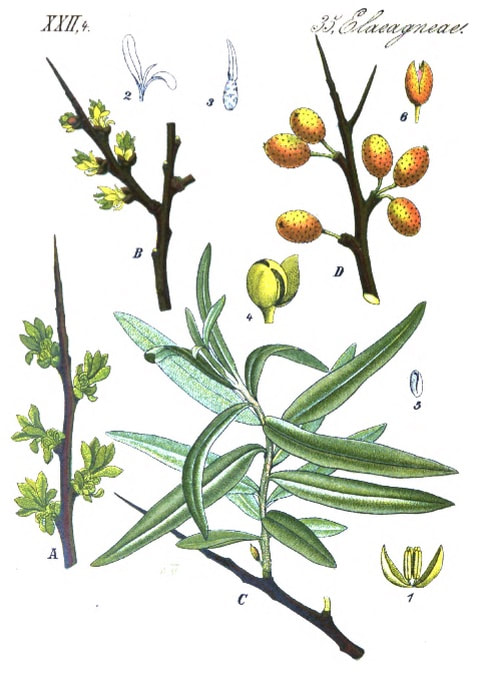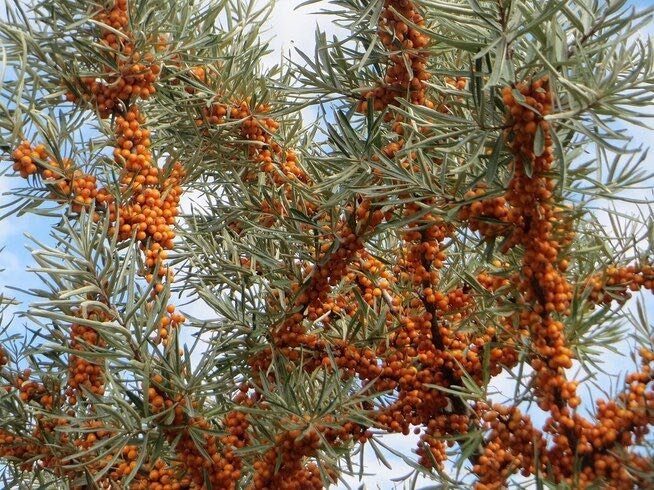Sentry Page Protection
Hippophae, Sea Buckthorn, Star Bu སྟར་བུ
Star Bu (Tibetan)
Sha Ji 沙棘 (TCM)
Sha Ji 沙棘 (TCM)
Flora von Deutschland (10), Kohler, 1882
Botanical name:
Hippophae spp.
Three types are used in Tibetan Medicine:
Parts used:
Fruit
Temperature & Taste:
Warm, moist. Slightly sweet, sour.
Hippophae spp.
Three types are used in Tibetan Medicine:
- H. rhamnoides (Large Star bu)
- H. salicifolia (Medium Star bu)
- H. tibetana (Small Star bu)
Parts used:
Fruit
Temperature & Taste:
Warm, moist. Slightly sweet, sour.
Uses:
1. Tonifies Qi, Generates Fluids:
-used for Qi deficiency with damage to fluids; after chronic disease, strong Heat, or Febrile disease.
-Diabetes
2. Benefits the Lungs, Stops Cough, clears Cold Phlegm:
-chronic Cough, Bronchitis, especially for profuse Cold Phlegm
-difficulty Breathing from Cold-Phlegm
3. Warms and Strengthens Stomach and Spleen:
-Indigestion, abdominal pain from Food Stagnation (Chinese Pharmacopeia)
-chronic Diarrhea or Dysentery with food stagnation
-Enteritis, Colic in Tibetan Medicine
-more recently for Gastro-duodenal Ulcers
4. Moves the Blood, clears Stasis (TCM, Tibetan):
-Amenorrhea, Dysmenorrhea
-Bruising, Hematoma, Trauma, Tumors; used for blood stagnation in TCM and Tibetan Medicine
-poor blood circulation causing thickening of the blood
5. Clears Heat:
-Fever (Tibetan Medicine)
-taken to prevent infection during epidemics
-topically for burns including sunburn and radiation burns
Dose:
Decoction: 3–9 grams
Preparation:
1. Steamed Sea Buckthorn:
The fruit is sometimes steamed before drying.
2. Sea Buckthorn extract (Khanda):
Boil the fruit, remove the seeds, then concentrate to an extract.
This cures Lung diseases and clears thick phlegm and resolves Blood stasis. (Tibetan)
Substitutes:
1. In Buryat region, Siberian Barberry (Berberis siberica) fruit is used.
2. Plums have also been recommended as a substitute in the Buryat region.
Decoction: 3–9 grams
Preparation:
1. Steamed Sea Buckthorn:
The fruit is sometimes steamed before drying.
2. Sea Buckthorn extract (Khanda):
Boil the fruit, remove the seeds, then concentrate to an extract.
This cures Lung diseases and clears thick phlegm and resolves Blood stasis. (Tibetan)
Substitutes:
1. In Buryat region, Siberian Barberry (Berberis siberica) fruit is used.
2. Plums have also been recommended as a substitute in the Buryat region.
Main Combinations:
1. Damage to fluids after febrile disease, Sea Buckthorn with Ophiopogon Mai Men Dong
2. Cough and Wheezing from excess Cold Phlegm, Sea Buckthorn with Astragalus Huang Qi, Atractylodes Bai Zhu and Pinella Ban Xia
3. Lung heat Cough, Bronchitis, Asthma, Sea Buckthorn with Licorice, Raisin, Emblic Myrobalan and Costus (as in Sea Buckthorn 5 of Tibetan Medicine)
4. Dysenteric disorders, Sea Buckthorn with Pulsatilla Bai Tou Weng
5. Menstrual disorders associated with Blood stagnation, Sea Buckthorn with Ligusticum Chuan Xiong, Angelica Dang Gui and Cyperus Xiang Fu
6. Hematoma and Bruising, Sea Buckthorn with Dragons Blood, Frankincense and Myrrh
Major Formulas:
Sea Buckthorn 5 (Star bu lnga pa)
Sea Buckthorn 19 (Star bu bcu dgu)
Auscpicious Conqueror (Bkra shis rnam rgyal) (Tibetan)
Conqueror of Brown Phlegm (Smug po gyul rgyal).
Cowrie Ash 8 ('Gron thal brgyad pa) (Tibetan)
Death Healing Nectar (Tibetan)
Greater Universal Women's Disease Conqueror (Mo nad spyi 'joms chen mo) (Tibetan)
Pacific 11 (Zhi byed bcu gcig) (Tibetan)
Principle 25 (Gtso bo nyer lnga) (Tibetan)
Women's Universal Decoction (Mo nad spyi thang) (Tibetan)
Cautions:
Not used in internal Cold or Fire from excess
Main Preparations used:
Concentrated Decoction of Sea Buckthorn:
The fresh fruit are washed, then boiled in water for 1–2 hours. The decoction is poured off and kept, fresh water is added and again boiled 1–2 hours, then strained. The two decoction are combined and left to sit for 12 hours to settle. Decant the liquid and filter the residue, then boil gently down, stirring continually, until it is as thick as honey, and won't seep through paper.
Not used in internal Cold or Fire from excess
Main Preparations used:
Concentrated Decoction of Sea Buckthorn:
The fresh fruit are washed, then boiled in water for 1–2 hours. The decoction is poured off and kept, fresh water is added and again boiled 1–2 hours, then strained. The two decoction are combined and left to sit for 12 hours to settle. Decant the liquid and filter the residue, then boil gently down, stirring continually, until it is as thick as honey, and won't seep through paper.
Click the Tabs above for more information on this Medicin
Nothing at the moment


